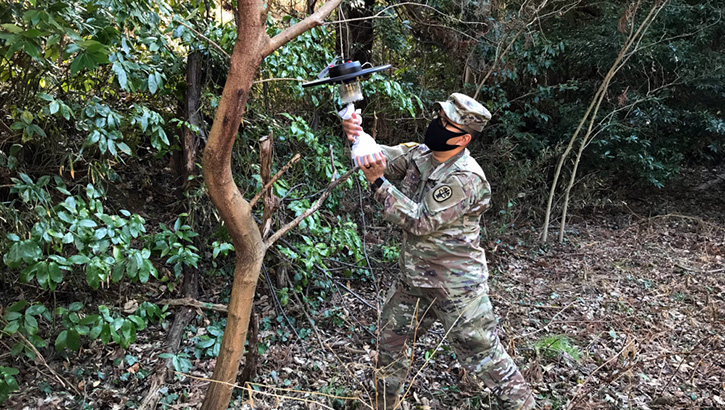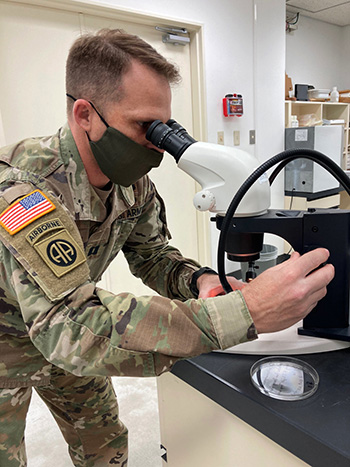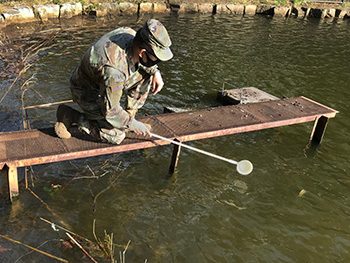New Army surveillance program designed to keep service members safe
 Army Staff Sgt. Matthew Pascual, noncommissioned officer in charge of entomology for Public Health Command-Pacific in Japan, collects mosquito specimens from a surveillance light trap to test for vector-borne pathogens of human concern on Camp Zama, Japan, Feb. 25, 2021 (Photo by: Public Health Command - Pacific).
Army Staff Sgt. Matthew Pascual, noncommissioned officer in charge of entomology for Public Health Command-Pacific in Japan, collects mosquito specimens from a surveillance light trap to test for vector-borne pathogens of human concern on Camp Zama, Japan, Feb. 25, 2021 (Photo by: Public Health Command - Pacific).
This spring, the Army's Public Health Command-Pacific's Entomology and Environmental Molecular Biology Laboratory service lines will launch the first ever Pre-Exercise Vector Surveillance program for the Indo-Pacific region.
The new initiative is a pilot program funded by the Global Emerging Infections Surveillance program, also known as GEIS, a section of the Armed Forces Health Surveillance Branch.
The vision of GEIS is to mitigate the threat of emerging infectious diseases to the U.S. military through a global laboratory network. The network is designed to help influence force health protection decision-making and enhance global health security.
One of the primary ways GEIS accomplishes this task is by providing timely, actionable infectious disease surveillance information to Geographic Combatant Commands and partner agencies, according to Army Maj. Michael Kwon, director of PHC-P's Environmental Health Services Directorate.
"This initiative acquires fresh data on health threats related to vector-borne diseases," Kwon explained. "The goal is to provide combatant commanders with relevant intelligence on the prevalence of pathogens transmitted by arthropods, in order to make informed force health protection decisions."
Typically, vector-borne disease data is collected by advance exercise parties as part of an occupational and environmental health site assessment, or OEHSA.
"Field parties put in the heroic effort to get checklists completed, but there are competing interests for time. Often individuals prioritize those tasks they are most versatile in," explained Kwon. "Historically, environmental scientists focused on potable water, air sampling for industrial chemicals, or collected data on other health threats, and insufficient time is spent on trapping for vectors.
 Army Capt. John Eads, chief of entomology for Public Health Command-Pacific in Japan, examines a vector sample in a microscope at Camp Zama, Japan, Feb. 25, 2021. This spring, Eads and his team will launch the first ever Pre-Exercise Vector Surveillance program for the Indo-Pacific region (Photo by: Public Health Command - Pacific).
Army Capt. John Eads, chief of entomology for Public Health Command-Pacific in Japan, examines a vector sample in a microscope at Camp Zama, Japan, Feb. 25, 2021. This spring, Eads and his team will launch the first ever Pre-Exercise Vector Surveillance program for the Indo-Pacific region (Photo by: Public Health Command - Pacific).
Army Capt. John Eads, chief of entomology at Camp Zama, Japan, recognized these hindrances to achieving an accurate site picture, namely a lack of standardized methodology, inconsistent manpower or capabilities.
So, when he first joined the PHC-P team, he began to find ways to leverage the PHC-P entomology program to better fit the needs of the Army and Department of Defense to keep service members safe from vector-borne diseases.
"When I first got here, the entomology program had potential to be more expansive, with a larger footprint than the local area," explained Eads. "The vision is to build the program to collect more data, more information, and improve the site picture of what was going on within Indo-Pacific as far as vector surveillance and pathogen detection."
"You can see with the pandemic, how quickly a disease can spread. That same concept applies to vector-borne diseases," Eads said. "For example, if there are Soldiers in the Philippines for an exercise who contract dengue [fever], they can transmit this to others. During peak mosquito season it could be just a matter of weeks before a traveler contracts the infection and perpetuates the cycle."
In early 2020, Eads was invited to Hawaii to brief military leaders on the importance of understanding vector-borne disease threats.
Eads attended his first GEIS meeting during this trip, and learned about how GEIS contributes to the protection of DOD healthcare beneficiaries and the global community through an integrated worldwide emerging infectious disease surveillance system.
"That's where I was first introduced to GEIS and their mission and vision, and it seemed to line up perfectly with my concept of one team from all branches working together to produce the best vector-borne disease data," he said.
Eads recognized the powerful potential for providing combatant commanders with actionable intelligence on disease threats for the different environmental terrains of the Indo-Pacific region.
To kick start the initiative, Eads reached out to other subject matter experts at the Armed Forces Research Institute of Medical Sciences, also known as AFRIMS, to devise ways to utilize GEIS to obtain funding and solve force health protection gaps.
By June 2020, Eads had received leadership buy-in, and several days later submitted his official GEIS proposal to partner with AFRIMS teammates.
 Army Staff Sgt. Matthew Pascual, noncommissioned officer in charge of entomology for Public Health Command-Pacific in Japan, samples for mosquito larvae during a vector surveillance survey on Camp Zama, Japan, Feb. 25, 2021. Collecting vector samples allows for PHC-P scientists to analyze areas of interest for potential vector-borne diseases that could impact the health of the force (Photo by: Public Health Command - Pacific)
Army Staff Sgt. Matthew Pascual, noncommissioned officer in charge of entomology for Public Health Command-Pacific in Japan, samples for mosquito larvae during a vector surveillance survey on Camp Zama, Japan, Feb. 25, 2021. Collecting vector samples allows for PHC-P scientists to analyze areas of interest for potential vector-borne diseases that could impact the health of the force (Photo by: Public Health Command - Pacific)
"AFRIMS in Thailand specializes more in animals such as rodents, collecting the rodents for testing for leptospirosis and other pathogens that we don't test for," explained Eads. "[AFRIMS] has a lot of biologists, so by partnering with them we could add to our capabilities and help each other out. So we included them in our proposal to GEIS and they included us in theirs."
One of the main objective of the PHC-P proposal was to standardize a surveillance program throughout the Indo-Pacific utilizing committed assets synchronized with GEIS, AFRIMS, and U.S. Army Pacific.
The goal is to capture population and activity data on vectors identified in the region and assess the presence and prevalence of pathogens in locations occupied by DOD personnel.
"We want to build joint knowledge products that can be used by both GEIS and combatant commanders," said Eads. "Final products will be two different formats of scientific data, one for GEIS and the other is real-time health risk assessments for combatant commanders."
By developing these products, Eads and AFRIMS will identify threat variables, not only for operational considerations, but also for the development of integrated pest management programs.
Kwon said the information provided by the products will have wide-ranging applications.
"The data that is released by the Army and GEIS gets used by a lot of researchers and scientists," he said. “A lot of people in public health career fields depend on having reliable data that is consistent."
One of the ways the PHC-P Pre-Exercise Vector Surveillance program will accomplish consistent data collection is by standardizing equipment and developing standardized operating procedures using next generation sequencing.
"We are now able to conduct next generation sequencing from anywhere on the planet with a device small enough to fit in your backpack," explained Gary Crispell, a microbiologist at the PHC-P EMBL at Camp Zama. "These tools have only been around for a few years, but are being rapidly adopted for the scientific research community."
"By being on that cutting edge of science having the most up-to-date equipment, having SMEs [subject matter experts] in the field, and a bioinformatics technician, we will have the possibility to protect all DOD personnel throughout the region by identifying diseases or health risks before they become a problem," added Eads.
Moving forwards, the team will lay the groundwork for a fully standardized vector surveillance program that the U.S. Indo-Pacific Command can use before key exercises to keep service members safe and healthy.
To learn more about the PHC-P entomology program, visit their webpage.